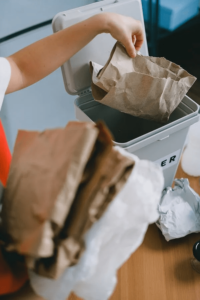The other day, I was at an event where someone handed me a pamphlet whose main message was to save trees! Strewn all around me were the pamphlets that people had discarded! Ironic, isn’t it? It got me thinking about how we use paper.
How many times have we thrown a notebook that still had a few blank pages left? Or how many one-sided pages have we tossed in the trash? Or paper bags, even?
 If we knew these numbers, we wouldn’t do that again!
If we knew these numbers, we wouldn’t do that again!
Around 42% of the industrial trees that are grown are used just for making paper. So it figures that we must use the output wisely.
The world uses 300 million tons of paper each year and its consumption has risen by 400% in the last 40 years.
Each sheet of paper is also made using a very water-intensive process, taking 300-400 litres of water to produce one kilogram of paper. After use, about 40% of landfills are waste paper.
Gloomy? Sure. Inevitable? We don’t think so!
Here’s how companies and individuals can help move towards lower paper use.
The maximum use of paper, unsurprisingly, is by corporations and the government. However, things are changing. If there is one good thing to have come out of COVID, it’s that companies were forced to go paperless in many of their systems!
Google Drive, Google Classrooms, Miro, Zoom, and other apps have helped decrease the amount of paper that was used in many office applications. Advances in Cloud Storage systems have made sharing of files and documents not just easier, but also more secure.
While paper can likely never be eliminated from the office, it can come very close to that. However, none can deny the absolute pleasure of writing something on paper, or doodling on paper!
Some things that can help with proper management of paper waste are:
- Choose paper that is ethically made. Yes, paper is supposed to be harvested from trees raised specifically for that purpose. To ensure this, look for Forest Stewardship Council (FSC), or comparable certification in your paper.
- You can also look for recycled paper, which takes waste paper and converts it into fresh paper again. It not only reduces CO2 emission but saves landfills from the paper mess. Different quantities of waste paper are used in this process. The higher the waste paper content, the more eco-friendly it is.
- Sustainable paper is one kind of paper that is gaining popularity, especially for personal use. This uses materials that are annual crops, or leftover waste that would have otherwise been thrown away: Hemp, grass, tea waste, bamboo, coffee husk, stone paper or cotton.
For example, cotton paper is known for its durability and strength. It is one of the finest papers and used extensively by artists. This paper can also be produced by hand, for what is popularly called handmade paper.
To make cotton handmade paper, cotton linters are first processed to remove any seeds and dust. Then, it is matted with water to get a good consistency of the pulp. Further processes like pulp cooking, pulp washing, and pulp screening take place before it is ready to bleach as per requirements.
Just like cotton, each material has unique qualities which led to their adaptation in the paper making process and replaced wood pulp.
Working with handmade paper, especially for journaling, can be good for the mind, and for the environment.
Better choices lead you to better places!


